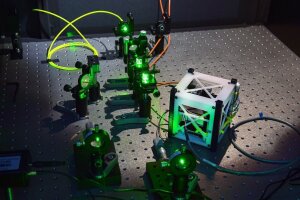
Falk Eilenberger is the head of the Junior Research Group Photonics in 2D-Materials at the Institute of Applied Physics. In his current position he is mainly interested in harnessing the physics of novel materials by integrating them with optical systems. The group is dedicated to the understanding of light-matter-interaction in atomically thin layers of nanomaterials, to the tailoring of their optical response, and to leverage their properties for applications in photonics. It is particularly focused on transition-metal dichalcogenides (TMDs), which naturally form mono-molecular and semiconducting sheets thinner than a nanometer but with an enormous degree of optical activity. These effects are driven by their unusual geometry: electrons can move quite freely within the layer but are confined in the vertical direction.
Their extreme electro-optical properties and miniscule size make them ideal workhorses for fundamental investigations in the nano- and quantum-photonic realm. Fundamental effects such as fluorescence, nonlinear interaction or the emission of quantum states of light have been observed for TMDs. Their dependence on the electronic and photonic properties of their environment and their femtosecond dynamics remain, however, largely unexplored. TMDs are also interesting candidates for a plethora of applications in photonics, ranging from microscopy over novel kinds of photonic components all the way to quantum light sources. The BMBF-funded junior research group "NanoScopeFutur-2D", led by Falk Eilenberger, aims to explore such applications, investigate fabrication routes, and demonstrate their usage for real-world application scenarios.
In October 2022, Falk Eilenberger also became Head of Department for Micro- and Nanophotonics at the Fraunhofer Institute of Applied Optics and Precision Engineering, JenaExternal link.
Research Areas
2D-Materials consist only of a single layer of atoms and exhibit unique optical phenomena. They are direct semiconductors, have intrinsic chiral symmetry breaking and host to single photon emitters. Dr. Eilenberger’s team is researching methods to integrate these novel materials in micro- and nanooptical systems, e.g. optical fibers, waveguides, and resonators and techniques to characterize their behaviour. This helps understanding their phenomena and harness them for nextgeneration devices in nonlinear photonics, sensing, and quantum communication.
Teaching Fields
- Introduction to Quantum Communication
- Introduction to Nanooptics
- Quantum Computing
Research Methods
The team and its collaborators are operating tools to experimentally realize and study optical systems embedded with 2D-Materials, among them are:
- Optical characterization tools: photon-lifetime microscopy, nonlinear spectroscopy
- Nanocharacterization tools: SEM, AFM, optical near fields microscopy
- Ultrafast pulse measurement techniques: FROG, DSCAN, COPRA; adaptive spectral pulse shaper
- Quantum-optical characterization tools: HBT- and HOMspectrometer, high order interference experiments
- Quantum photonics prototyping: systems integration and test for space-based QKD-systems

Recents Research Results
Two-dimensional materials can be integrated with almost all optical systems. Among these we have focused on optical resonator and guided wave systems, as both enhance the light-matter interaction strongly. The former does so at a specific wavelength – termed resonance wavelength – which can also be tuned to match a fundamental excitation of the material itself. If the resonant interaction is perturbative then we can sharpen emission features and suppress emission sidebands, which we have used to create bright and tunable single-photon emitters of highest quality, which operate at room temperature [1]. We have also shown that such a system is suitable for QKD applications in space [2]. If the interaction is, however, strong enough we observe a hybridization of photonic and material resonances giving rise to a new class of quasi-articles, called exciton-polaritons [3]. These consist partially of matter and partially of light and can exhibit phenomena rooted in either of the domains such as Zeeman-splitting and condensation dynamics. We are also active in the development of monolithic high-q resonators, which contain 2D- and classic optical materials and a fabricated in a single-process [4].
Guided wave systems enhance light-matter interaction by increasing the interaction length from sub-nanometer to possibly the length scales of meters for optical fiber or to chip-scale for semiconductor waveguide. We have recently [5] demonstrated that 2D-materials can be grown at high quality directly on the core of optical fibers. We have also demonstrated that fundamental properties of the two-materials can now be addressed in guided wave systems, by showing that even a coating of just one atomic layer leads to guided wave fluorescence and to enhanced nonlinear interactions, both of which are mediated by 2D-materials.
[1] Vogl et al., Nature Commun. 10, 1202 (2019).
[2] Vogl et al., ACS Photonics 6, 1955 (2019).
[3] Rupprecht et al., 2D Materials 7, 035025 (2020).
[4] Knopf et al., Opt. Mater. Express 9, 598 (2019).
[5] Ngo et al., Adv. Mater. 32, 2003826 (2020).
